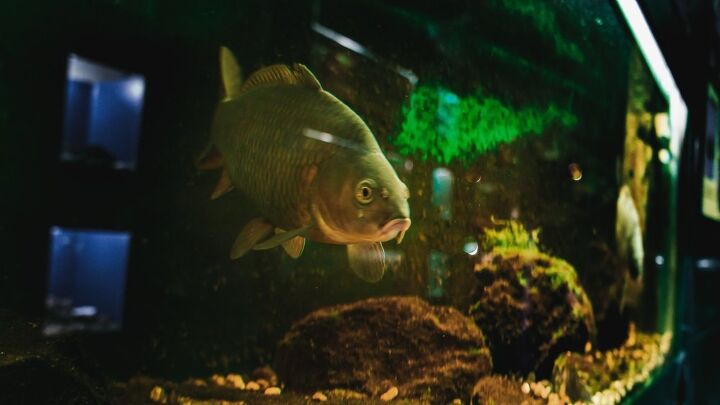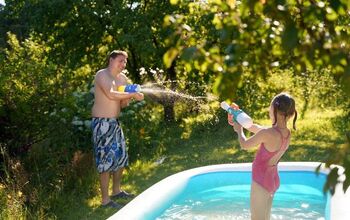What To Do With A Fish Tank When The Power Goes Out

Fish tanks are hard enough to take care of even without an inconvenient power outage. Much of what makes our fish tanks safe and healthy relies on power, whether it be the air pump and filter or heater. Understandably, many people struggle with what to do with a fish tank when the power goes out.
Put a portable air pump in your fish tank when the power goes out to maintain healthy oxygen levels. Wrap the sides of your fish tank with a blanket during a winter power outage to protect your fish. Stir the water in your tank to agitate the surface, and avoid feeding your fish too much during the outage.
You can make your fish overactive if you feed them too much when the power is out, which depletes oxygen. Follow along as we explore what to do with a fish tank when the power goes out.
How Long Can A Fish Tank Go Without Power?
A fish tank can go anywhere from 2 to 12 hours without power, even if you do nothing to help the situation. However, a fish tank can last several days without power if you carefully monitor and maintain it. The lack of filtration and air pumps are the biggest risks for a fish tank during a power outage.
This can reduce the water agitation and oxygen levels within the fish tank. Once that happens, you may notice your fish stick close to the water's surface. That is a sign they need oxygen.
Power outages often get resolved within a day or two, so many fish hobbyists have no problems. That said, your fish may suffer health problems if you overfeed them or fail to check on them during an outage.
What To Do For Your Fish Tank In A Power Outage
It’s easy to panic when the power goes out, but it’s not as hard to protect your fish tank as you may think. Whether it be agitating the water surface or putting ice in the tank, many methods can keep your fish safe. Keep in mind that each tank differs when it comes to size, volume, temperature requirements, and fish.
1. Use A Portable Air Pump
Portable air pumps can help keep your fish tank clean and safe when the power goes out. You can easily set up a battery-operated pump during a power outage without disrupting your fish. Standard air pumps fail when the power goes out if you don’t have a backup generator.
The air pump is ultimately the part of your fish tank you should worry about most during severe storms. Your fish may start to struggle to get oxygen after 2-3 hours without an air pump. Granted, they won’t die right away, but going that long without a pump can affect their health.
Simply keep a backup battery-powered air pump at home for emergencies. It also helps to keep some extra batteries around in case the power outage lasts several days.
2. Try Not To Feed Your Fish
It may be tempting to feed your fish when the power goes out, but it can backfire. Eating makes fish more active, and that makes them consume oxygen. The oxygen level within the tank can be depleted if you don’t have a backup air pump.
This can become dangerous for the fish if the power outage lasts up to 5-8 hours or longer. Many fish can go several days without food, so you don’t have to worry.
3. Stir The Water
Water surface agitation is one of the best ways to oxygenate your tank, and that’s crucial during outages. Filters and air pumps can agitate the surface, but you can also do it manually. For example, you can increase the oxygen level if you pour water into the tank from a height.
Make sure you don’t pour the water in too fast and forcefully. That can make the substrate float up and your tank may look messy. You can also simply stir the water with a stick or long object to keep the oxygen flowing when the power goes out.
4. Perform A Small Water Change
Depending on how long the power has been out, you may want to perform a small water change in your tank. Only change up to 25% of the water to ensure you don’t alter the tank’s temperature too much. It’s important to only change a little bit of the water in your fish tank, since your filter won’t work.
You can upset the fish if you change more than 25% of the water, and they won’t be happy. Many people don’t even need to change the water when the power goes out. Only change the water if your tank is dirty and the temperature is healthy. You should also only change some of the water if you have a battery-operated air pump.
5. Wrap The Sides Of The Tank
Is your house quickly becoming cold? If so, it’s only a matter of time before the water in your fish tank gets cold. Without a backup generator, you can’t run the heat in your home or fish tank, and the water temperature will slowly drop.
You can combat this if you wrap the sides of your fish tank with a blanket. This helps retain heat within the tank so the water temperature doesn’t change too much. Most fish tanks rely on an internal temperature of 75-80 degrees Fahrenheit.
That said, you cannot cover the top of the fish tank with a blanket. Your fish tank can quickly become moldy if you cover the top, as the evaporating water has nowhere to go. Use tape to secure a blanket on the sides if it struggles to stay up.
6. Cool The Water
The water in your fish tank may overheat when the power goes out during summer. In that case, you can use ice cubes and small bags of ice to cool the water. This will not only cool the water, but it will also help oxygenate the tank.
That said, you must be careful not to put too much ice in your fish tank. The last thing you want is to raise the water level too high. Try to also block sunlight in the room with your fish tank to cool the water during a power outage.
Summing It Up
Keep a portable air pump handy at home to oxygenate your fish tank when the power goes out. Don’t feed your fish too much during a power outage, as that makes them consume more oxygen. Occasionally stir the water and pour a little water from a high height to oxygenate your fish tank during an outage.
Related Guides:

Nick Durante is a professional writer with a primary focus on home improvement. When he is not writing about home improvement or taking on projects around the house, he likes to read and create art. He is always looking towards the newest trends in home improvement.
More by Nick Durante



























